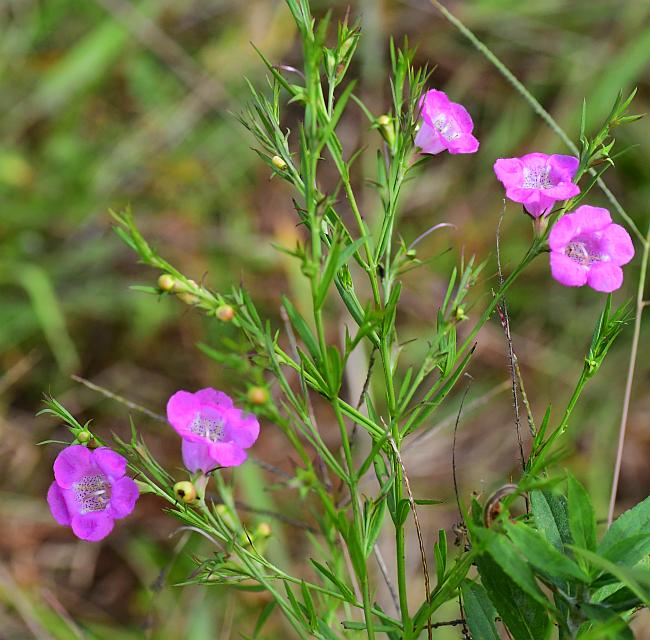Agalinis heterophylla (Nutt.) Small
Prairie False Foxglove

Native
CC = 10
CW = 3
MOC = 4
SRank = S1
© SRTurner
Agalinis heterophylla (Nutt.) SmallPrairie False Foxglove | |
 |
Native CC = 10 CW = 3 MOC = 4 SRank = S1 |
© SRTurner |
|
Family - Orobanchaceae Habit - Annual hemiparasitic forb. Stems - Erect, to 80 cm, with numerous, spreading to ascending branches, mostly above the midpoint, 4-angled and ridged, glabrous or more commonly sparsely roughened with minute, ascending hairs, mostly along the angles, toward the tip.
Leaves - Opposite, simple, sessile, usually lacking axillary fascicles. Blades ascending, 15-35 mm long, those of the largest leaves 2-6 mm wide, linear-lanceolate, those of the lower leaves sometimes deeply 3-lobed or -parted (these often withered by flowering), the upper surface and margins moderately roughened, the undersurface roughened along the midvein.
Inflorescence - Spikelike racemes, the flower stalks 1-3 mm long at flowering (shorter than the calyces), not or only slightly elongating at fruiting, usually curved outward.
Flowers - Calyces 5-10 mm long, bell-shaped, longer than wide at flowering, the lobes 3-6 mm long, usually noticeably longer than the tube, stiff, narrowly lanceolate-triangular, glabrous, the sinuses between the lobes variously narrowly to broadly V-shaped or somewhat U-shaped. Corollas 20-32 mm long, pink to pinkish purple, the tube densely and finely short-hairy externally, the throat pale or white with dark purple spots, glabrous, the lobes glabrous internally but fringed along the margins, the upper 2 lobes spreading to somewhat bent backward. Stamens 4, the filaments of 2 lengths, hairy, the anthers with 2 sacs, these more or less parallel, variously blunt to tapered at 1 end, light yellow, hairy. Style curved, the stigmatic portion elongate and somewhat flattened.
Fruits - Globose, glabrous, 5-8 mm long. Flowering - August - September. Habitat - Prairies, sand prairies, savannas, moist swales, roadsides. Origin - Native to the U.S. Lookalikes - Other members of the genus. Other info. - This species is uncommon in Missouri, so far reported from only five counties. This is unfortunate, as it is a strikingly beautiful plant when in full bloom, with flowers among the largest within its genus. Its main range is to our south, largely confined to Arkansas, Louisiana, Texas, and Oklahoma. It is state listed as critically imperiled in Missouri. The plant can be identified by its habitat, three-lobed lower leaves (if present), short pedicels, large calyces with prominent lobes, and pink flowers. The pedicels are equal to or shorter than the calyx tube. The three-lobed lower leaves are typically dried by the time the flowers appear. Photographs taken off Hwy 65 near Gould, AR., 9-8-06 (DETenaglia); also at Duck Creek Conservation Area, Wayne County, MO, 10-5-2021 (SRTurner). |